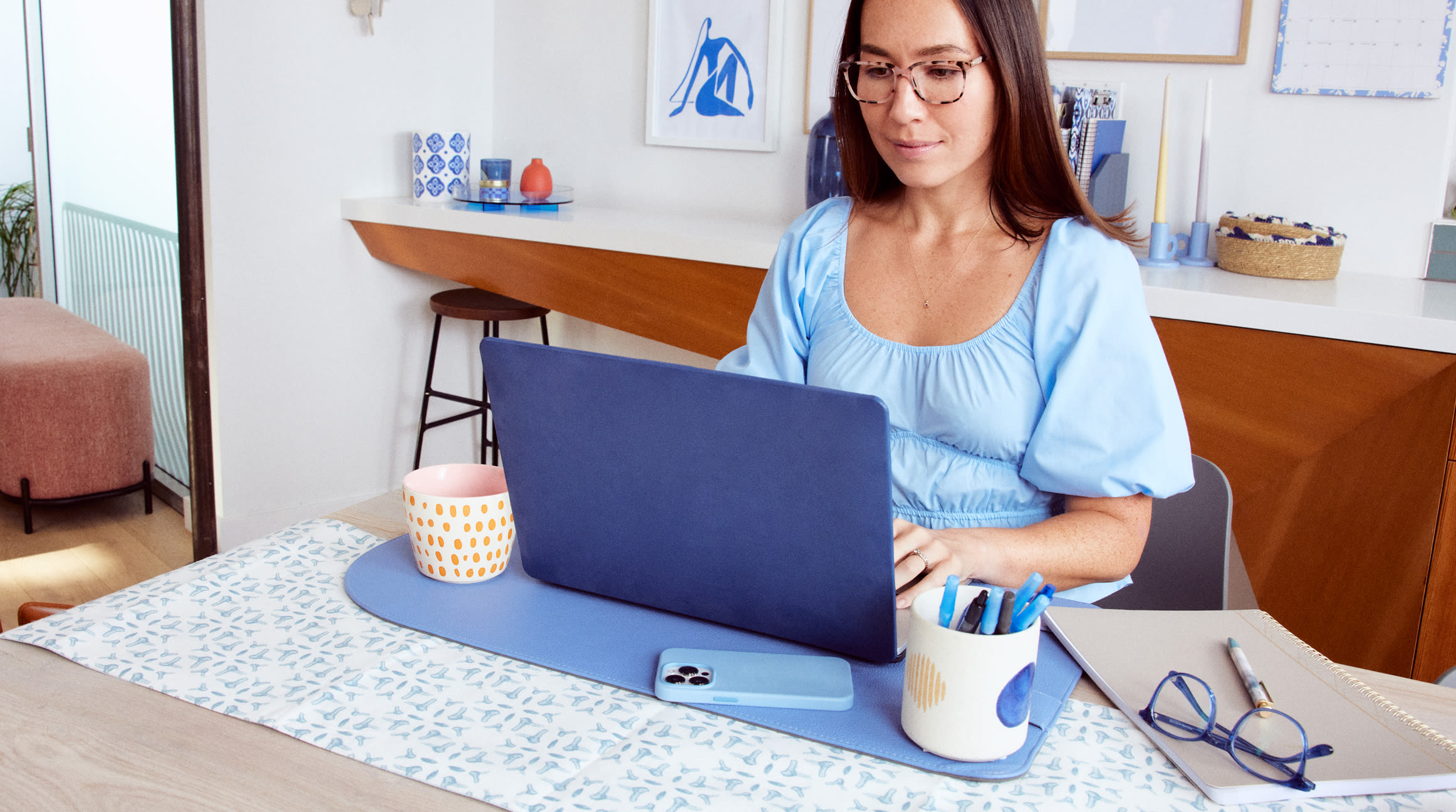Digital Eye Strain: Top Tips to Prevent Symptoms from Screen Time

If you spend a lot of time on a computer, you’ve likely experienced some sort of digital eye strain, also referred to as computer vision syndrome. It’s a common problem that affects people who spend time on any screen of a computer or digital device, including computers, tablets, e-readers and cell phones. Eye care is important, particularly as we get older and includes more than just vision exams and upgrading your eyeglasses. People of all ages need to pay attention to digital eye strain symptoms so they can seek proper treatment before they damage their eyes or cause further health problems.
The Causes of Digital Eye Strain/Computer Vision Syndrome
What are the biggest causes of digital eye strain? They can vary, but most of them are of course related to time spent looking at a screen. They include:
- Prolonged screen time
- Poor overhead lighting
- Screen glare
- Preexisting health or eye problems
- Bad posture resulting in improper viewing angles
- Sitting too close to the screen
- Not taking breaks
- Not blinking frequently enough/dry eyes
- Stress
Any of those problems alone can cause digital eye strain, but the chances increase if there is a combination of any of the above reasons.
Symptoms of Digital Eye Strain
There are several symptoms of digital eye strain; some can also be indicative of a different vision or health problems, so it’s imperative to seek professional advice if the problems continue. Symptoms can include:
- Dry eyes
- Blurry vision
- Headache
- Gritty or sandy feeling in the eyes
- Heavy eyelids
- Red eyes
- Difficulty in keeping eyes open
- Muscle strain or tightness in neck and/or shoulders
- Eye pain
Risk Factors of Digital Eye Strain
Not seeking proper digital eye strain treatment can have adverse effects on vision. It can make it difficult for you to get work done on a computer or enjoy a reading or a television-watching session if you’re suffering from eye strain. Begin taking steps to reduce it before it worsens, while understanding that some people will have an increased risk for developing it, beginning with those who fit any of the below situations. Issues can begin within even 15 minutes of digital device usage in the worst circumstances.
Unusually Long Periods of Uninterrupted Time at a Screen
Studies show that between two to six hours of staring at a screen can cause vision difficulties. For some computer users with additional circumstances, even shorter periods of time can cause problems.
Increased Daily Use of Digital Devices
Over the past few years, more people are spending longer hours on their electronic devices, and many of us own even more devices than ever before. We step away from our computer and pick up our phone, and at night, we turn on our e-reader and check our email before we go to sleep. We’re too frequently on one of our many devices overall.
Not Wearing Prescribed Glasses or Contacts When Using a Device
If you are farsighted, you may take your glasses off when using an electronic device or when you are sitting at a desk. This may not seem like an immediate cause for concern, but if you fail to make the project adjustments rather than just holding the phone closer to our face, you could be causing eye strain that may not be immediately evident. You should always use our prescribed eyewear as our eyecare professionals suggest.
Uncorrected Vision or Eye Health Problems
It’s important to get regular eye exams and stay on top of your eye care all throughout the year, not just when it is time for an updated prescription for glasses or contacts. Vision problems, such as glaucoma or refractive errors, may require even more frequent eye exams. Some health issues can affect eyes, such as blood pressure, so it is also recommended to get regular physicals to be aware of any physical problems that seem unrelated to eye care but may have adverse effects on eye health. Use Hubble’s find a doctor feature to get set up with a doctor in your area.
Treating Digital Eye Strain
If you think you are experiencing signs and symptoms of digital eye strain, there are several things you can do. It may take some time to see an overall improvement, and you may need to try several of the following suggestions, rather than just one or two, to make a difference.
Use Artificial Tears
This is a short-term treatment to utilize and should not be done in place of seeking medical care from an eye professional, but eye drops made for this purpose are available in pharmacies. They may also be called wetting drops and are made by several manufacturers, with homeopathic options available.
Put Away Your Handheld Device or Step Away from Your Computer
Continuing to stare at a digital screen while experiencing any digital eye strain symptoms can worsen your vision, even temporarily. This can be difficult if you are working but even taking a small break can help. The 20-20-20 rule, explained further below, is a fast way to achieve this, but stepping away from your workspace for even five minutes is good for your eyes and your overall physical health. It’s important that if you get up and leave your desk for this break that you do not utilize your phone to check-in while away; give your eyes the reduced visual input they need and deserve.
Change Your Screen Settings
Do this once you return from having taken a break, so you can reduce the chances of the symptoms returning as quickly. Consider enlarging the font or adjusting the contrast and brightness to a level that is comfortable. There are also extensions you can add to your computer browsers that help with these modifications while browsing the web.
Apply a Cold Cloth or Compress
Sometimes eyes can swell or become red due to eye strain, and a cold cloth or compress applied lightly and gently over your eyes can offer some relief. Just be careful to not press too heavily and further irritate sensitive eyes.
Avoid Rubbing Your Eyes
This will further irritate sensitive skin and membranes and can cause redness and/or swelling.
Preventing Digital Eye Strain
Preventing a problem is always easier than fixing it once it has begun, so take a look at this cost-effective list of easy ways to stop digital eye strain before it starts.
Follow the 20-20-20 Rule
What is the 20-20-20 rule? It’s very easy! Every 20 minutes, look at an object that is 20 feet away for 20 seconds. This can be done in almost any setting and doesn’t require you to get up from your desk. This can even be accomplished during an online meeting or presentation. If you have a window available, even better. (This also can be a wonderful stress reliever!) If you get distracted and forget to do this every 20 minutes, consider setting a timer as a reminder.
Adjust Your Overhead Lighting
This can be harder if you are in an office setting outside of your home, but there are still things you can do in most cases. Remember that window mentioned above? Ideally, neither you nor your computer should face a window; this increases glare on your glasses, eyes and screens. The light streaming from a window can reflect badly onto your face and into your eyes, so desk/computer placement can mitigate this problem before it becomes one. Adjust the blinds throughout the day to minimize glare, no matter where your desk sits. Fluorescent lighting is not an eye-friendly option, but in public spaces, this may be out of our control, so consider a desk lamp with soft lighting when at all possible. LED lighting can be softer and is readily available in many options you can purchase for your workspace.
Sit the Proper Distance Away from Your Screen
The optimal working distance for your eyes away from the digital screen is approximately 25 inches, with your face being no closer than 20 inches and no farther than 40 inches. Push your monitor backwards if you are more comfortable with your arms resting on your desk, to avoid upsetting the rest of your posture to make this accommodation.
Utilizing Blue Screens or Night Mode Settings
E-readers, tablets and even cell phones have options you can find in your settings to activate a blue light filter or night mode. Some devices allow you to have this on a timer, so when you pick up your e-reader at night, it is already turned on, avoiding that bright burst of light in a dark room that can be a shock to your eyes. Each device is different, but directions should be available via a web search for your particular model.
Try Out a pair of Eye Strain Glasses
You can purchase these specialized glasses at eye care centers or some pharmacies. They may not all be the height of fashion (though there are very fashionable choices available) and will not take the place of prescription glasses, but they can be a good replacement for a blue screen or night mode on your computer and are portable, which make them useful for any digital usage situation on the go.
Maintain Healthy Eyes with Hubble
It can be very easy to get involved in work or another digital device activity, like a game on your phone or a video on a social media app, so you need to be mindful of eye care at all times. Once you begin to experience eye strain, you should treat it immediately. The good news is that digital eye strain is not permanent, but it can be entirely prevented if you take the proper steps to protect your eye and vision health once you begin feeling it occur.
With even small lifestyle changes, digital eye strain can be reduced or entirely eliminated, but be sure to stay on top of using and wearing only glasses and contacts with up-to-date prescriptions. An old contact or eyewear prescription will cause your eyes additional stress and strain. Even broken glasses will contribute to eye strain and vision problems.
Hubble.com is available to help provide affordable glasses and contacts from the comfort of your own home. All you need is a current prescription; Hubble can help you find a local eye doctor to start the process, then you can order online. Frames begin at only $48, and contact prescriptions start at $1 for the first box! Hubble also sells sunglasses beginning at $98, so they can meet all your eyewear needs.




